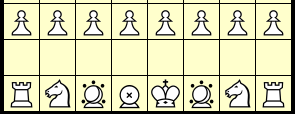Comments/Ratings for a Single Item
Correction to my previous comment: Timothy Newton is not Australian, just thorough enough in his research to give that impression. I also mistook his stereotyped opening to Outback Chess for a sign of the self-mocking irony that the Australians share with the British. I discovered my error in the interview with him as 84-square winner. Apologies to him if he is offended, but hopefully he will instead feel flattered for writing so convincing a themed game. To sum up the remaining claims of the Almay and Newton Kangaroos: Almay: age, very impressive leap. Newton: used in a game and a pzize-winning game at that, maintains beast-name convention of Gnu/Gazelle/Bison.
While I personally prefer the Newton Kangaroo, the Almay Kangaroo does have a couple of other things in its favor:
- There's no other name for that particular move. The Newton Kangaroo is also called a Hospitaller (and occasionally Princess).
- The Hospitaller's rotary counterpart (ND to its NA) is the Templar. The Kangaroo's is the Carpenter (with other names including Scribe, Ouroboros, and Doughnut). In a game with both pieces, Hospitaller and Templar makes the most sense.
But... the Newton Kangaroo has an easy Betza notation (NA). The Almay Kangaroo's move is interesting, but I'm not even sure how it can be notated.
PS: Am I the only one who finds the picture of the tailless Kangaroo disturbing? It looks like some other animal trying to do what a bear does in the woods.
 H. G. Muller wrote on Mon, Oct 2, 2023 06:49 PM UTC in reply to Bob Greenwade from 03:18 PM:
H. G. Muller wrote on Mon, Oct 2, 2023 06:49 PM UTC in reply to Bob Greenwade from 03:18 PM:It looks like some other animal trying to do what a bear does in the woods.
:-)
The XBetza for this Kangaroo is easy enough: two sliding hop legs followed by a final step. So pafpyafQ, or [pQ-pQ-K] in bracket notation.
PS: Am I the only one who finds the picture of the tailless Kangaroo disturbing? It looks like some other animal trying to do what a bear does in the woods.
You are not the only one.
The XBetza for this Kangaroo is easy enough: two sliding hop legs followed by a final step. So pafpyafQ, or [pQ-pQ-K] in bracket notation.
Easy for you, maybe.... :P
 H. G. Muller wrote on Tue, Oct 3, 2023 01:03 PM UTC in reply to HaruN Y from 12:30 PM:
H. G. Muller wrote on Tue, Oct 3, 2023 01:03 PM UTC in reply to HaruN Y from 12:30 PM:True, that would work too. I try to avoid the legacy use of p in multi-leg moves, though. I think the bracket notation [pQ-pQ-K] is very intuitive: hop twice as Q, and then land as K for capturing or moving. By making continuation in as much the same direction as possible the default in this context, it hardly needs any modifiers.
9 comments displayed
Permalink to the exact comments currently displayed.
